German Online
Pricing & Packages
Online classes fee:-
| COURSE | DURATION | FEE in INR (Domestic students) | FEE(International Students)in USD(Rate 85) |
| GERMAN | A1 (1.5 Months) | Rs. 12,999/- | $ 153 |
| A2 (2 Months) | Rs. 14,999/- | $ 177 | |
| B1 (2 Months) | Rs. 19,999/- | $ 236 | |
| B2.1 (1.5 Months) | Rs. 15,999/- | $ 189 | |
| B2.2 (1.5 Months) | Rs. 15,999/- | $ 189 | |
| C1 (25 Months) | Rs. 25,999/- | $ 306 | |
| GOETHE Exam (change as per Goethe time to time) | A1 & A2 | Rs. 10,000(approx each) | $ 118 (each) |
| B1 | Rs. 18,000(approx) | $ 212 | |
| B2 | Rs. 18,000(approx) | $ 236 |
German Classes Online Timings
| German Classes Online Timings | |
| Morning batch | 8:00 - 9:00 AM |
| Evening batch | 6:00 - 7:00 PM |
| 7:00 - 8:00 PM | |
| 8:00 - 9:00 PM | |
| 9:00 - 10:00 PM | |
| 10:00 - 11:00 PM | |
Crash Course Batches
| Crash Course Batches | |
| Do A1 in one month | 30 Hours (1.5 Hour each day) |
| Do A2 in one month | 30 Hours (1.5 Hour each day) |
| Weekend Batches | 30 Hours (1.5 Hour each day) |
| Includes | 30 Hours (1.5 Hour each day) |
| 30 Hours (1.5 Hour each day) | |
Meet: Your German language tour guide
How Long Does It Take To Learn German
The Goethe Institute says that you need to study German for at least 750 hours to get to an advanced level. This means that it is considered to be similar to English, and they estimate that German takes approximately 30 weeks, or 750 classroom hours to learn.
So, hey, less than a year if you really work hard doesn’t sound so bad, does it?
Learning German can be tough, especially if you are native to a language other than the Indo-European family of languages. But, regardless of your original language, and even if German appears difficult to you at first, do not be discouraged. If you practice every day for at least three to six months, you should be able to hold a daily conversation with a friend as well as enter a cafe and place an order in German.
To get to that level, some people struggle more than others and require more time, but this is primarily due to their failure to practice consistently and put in the necessary effort. It will likely take several years of practice to become fluent in German, but we’re just trying to get started, right?
L’alphabet with pronunciatoion
| L’alphabet with pronunciatoion | |||||
| A – A (ah) | B – Be (bay) | C – Ce (tsay) | D - De (day) | E – E (ay) | F - Ef (eff) |
| G – Ge (gay) | H – Ha (hah) | I – I (eeh) | J – Jott or Je (yot) | K – Ka (kah) | L – El (ell) |
| M – Em (em) | N – En (en) | O – O (oh) | P – Pe (pay) | Q – Qu or Que (koo) | R – Er (err) |
| S – Es (es) | T – Te (tay) | U - U (ooh) | V – Vau (fow) | W - We (vay) | X – Ix (iks) |
German Greetings (Deutsche Grüße)
- Hallo!
- Guten Morgen!
- Guten Tag!
- Grüß Gott!
- Guten Abend!
- Auf Wiedersehen!
- Tschüss!
- Hello!
- Good morning!
- Good day!
- Good day! (Used mostly in southern Germany and Austria)
- Good evening!
- Goodbye! (formal)
- Goodbye! (informal)

"Yes" and "No"
- Ja
- Nein
- Vielleicht
- Yes
- No
- Maybe

Counting in German (Zählen auf Deutsch)
| Number | German | English | Number | German | English |
| 0 | null | zero | 11 | elf | eleven |
| 1 | eins | one | 12 | zwölf | twelve |
| 2 | zwei | two | 13 | dreizehn | thirteen |
| 3 | drei | three | 14 | vierzehn | fourteen |
| 4 | vier | four | 15 | fünfzehn | fifteen |
| 5 | fünf | five | 16 | sechszehn | sixteen |
| 6 | sechs | six | 17 | siebzehn | seventeen |
| 7 | sieben | seven | 18 | achtzehn | eighteen |
| 8 | vier | eight | 19 | neunzehn | nineteen |
| 9 | neun | nine | 20 | zwanzig | twenty |
| 10 | zehn | ten | 30 | dreißig | thirty |
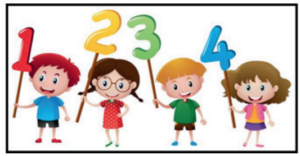 |
40 | vierzig | forty | ||
| 50 | fünfzig | fifty | |||
| 60 | sechzig | sixty | |||
| 70 | siebzig | seventy | |||
| 80 | achtzig | eighty | |||
| 90 | neunzig | ninety | |||
| 100 | einhundert (hundert) | one hundred (hundred) | |||
Grammar: German grammar can seem challenging at first, but once you understand the basics, it
becomes much easier when you start learning it under expert guidance and with special institute like
us (French German Guru Overseas). There are six tenses in German: Prasens, Präteritum, Perfekt,
Plusquamperfekt, Futur I and Futur II.
- Key concepts include:
- Nouns and Gender: German nouns are categorized into three genders: masculine (der), feminine (die), and neuter (das).
German nouns have another strange feature that we don’t have in English—every noun (person, place, and thing) has been assigned a gender: feminine, masculine, or neutral.
How do you know the gender of a word? You have to look at the word for “the” that comes before the noun.
- Masculine
- Feminine
- Neutral
- Plural
- der Mann
- die Frau
- das Kind
- die Kinder
- (the man)
- (the woman)
- (the kid)
- (the kids)

- Cases: There are four cases in German (nominative, accusative, dative, genitive), which change the form of articles and adjectives.
‘Dativ’ is the case of the indirect object. When there are one subject(Nominative) and two objects in a sentence, the direct object deals with things and takes the’ Akkusativ’ and the indirect object deals with the people and takes the ‘dativ’. When the two objects are represented by nouns, the Dativ precedes the Akkusativ
Examples:-
- Ich kaufe meinem freund das Geschenk (I buy my friend the gift).
- Ich- Nominativ subject
- Meinem freund – Dativ object
- Das Geschenk – Akkusativ object
- Verb Conjugation: German verbs change depending on the subject and tense (present, past, future).
You’ll need to know this basic verb: to be. In German, notice the verb morphs slightly depending on who it’s describing. (We’ll get into that more later, but for now, take a look at this one verb.)
Verb: sein (to be)
| 1 | I am | Ich bin |
| 2 | You are (informal) | du bist |
| 3 | You are (formal) | Sie sind |
| 4 | He is | er ist |
| 5 | she is | sie ist |
| 6 | It is | es ist |
| 7 | All of you are (informal) | ihr seid |
| 8 | All of you are (formal) | sie sind |
| 9 | We are | wir sind |
| 10 | They are | sie sind |
List of 12 verbs with two objects
| 1 | Kaufen | to buy |
| 2 | Mitbringen | to take along |
| 3 | Erzählen | to narrate |
| 4 | Erklaren | to explain |
| 5 | Schicken | to send |
| 6 | Schenken | to gift |
| 7 | Zeigen | to show |
| 8 | Leihen | to lend |
| 9 | Geben | to give |
| 10 | Schreiben | to write |
| 11 | Ein fallen | to occur |
| 12 | Wunschen | to wish |
- Pronunciation: German pronunciation is quite logical. The rules are consistent, and once you learn the basic sounds, it’s easier to pronounce new words correctly. Key tips:
- Focus on the “ch” sound (as in “ich” and “nicht”).
- Pronounce vowels clearly, as they can be short or long.
- Vocabulary: The German language has many words that are similar to English (cognates), such as “Computer”, “Telefon”, or “Hotel”.
- However, be aware of false friends like “gift” (which means poison in German) or “billion” (which means trillion in German)
Some Daily Expressions and German Phrases
Ich heiβe… – My name is…
Wie heißen Sie? – What’s your name?
Wie geht’s? – How are you?
Mir geht’s gut. – I’m doing well
Vielen Dank! – Thank you very much!
Mir geht’s nicht gut. – I’m not doing well!
Ich komme aus… – I’m from
Alles Gute zum Geburtstag – Happy Birthday
Ich bin hier wegen + Genitiv… – I’m here for…
Fröhliche Weihnachten – Merry Christmas
Wortschatz in Gruppen Eingeteilt (Vocabulary divided into groups)
CLASSIFIED VOCABULARY
Die Kleidung und das Zubehör (Clothing and accessories)

Der Anhänger Pendant
Der Gürtel Belt
Das Hemd Shirt
Das Kleid Dress
Die jeans Jeans
Der ohrring Earring
Die Toilettenartikel (Toiletries)

Der Kamm Comb
Die Seife Soap
Das Haarwaschmittel Shampoo
Die Schminke Make-up
Der Spiegel Mirror
Die Zahnbürste Toothbrush
Die Zhanpasta Toothpaste
Der Körper (The Body)
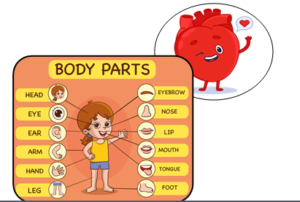
Das Auge Eye
Das Gesicht (er) Face
Die Hand Hand
Das Herz Heart
Der Mund Mouth
Dasa Ohr Ear
Familienmitglieder (Family Members)

Der Junge Boy
Das Mädchen Girl
Der Vater Father
Die Mutter Mother
Das Kind Child
Die Schwester Sister
Einige Sondergeschäfte (A few specialized shops)
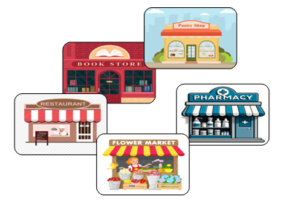
Die Apotheke Chemist Shop
Das Blumengeschäft Florist
Die Buchhandlung Book store
Das Restaurant/Cafe Restaurant
Die Konditorei Pastry shop
Wohnstätte und Zimmer (Habitations and rooms)
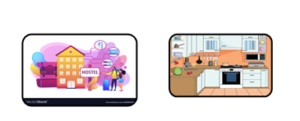

Das Badezimmer Bathroom
Das Doppelzimmer Double-room
Das Gebäude Building
Das Internat Hostel
Die Küche Kitchen
Möbelstüche und Geräte im Haus (Furniture and gadgets at home)
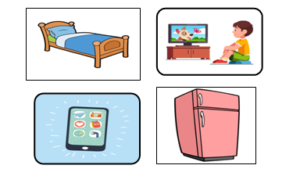
Die Badewanne Bath-tub
Das Bett Bed
Der Fernseher Television
Das Handy Mobile phone
Der Kühlschrank Refrigerator
Die Stadt (The City)
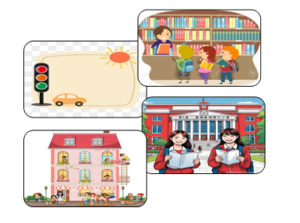
Die Ampel Traffic light
Der Baum Tree
Die Bibliothek Library
Die Straße Road
Die Universität University
Die Wohnung Apartment
Eßwaren und Getränke (Food and Drinks)
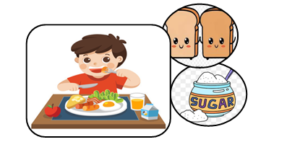
Das Frühstück Breakfast
Das Brot Bread
Die Milch Milk
Der Salat Salad
Das Wasser Water
Der Zucker Sugar
Geräte in der Küche (Utensils and Apparatus in the Kitchen)

Der Bsckofen Baking oven
Das Besteck Cutlery
Die Flache Bottle
Der Kessel Kettle
Der Teller Plate
Das Obst (Fruits)
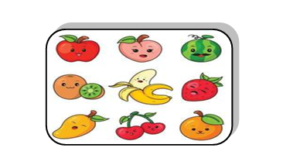
Der Apfel Apple
Die Banane Banana
Die Erdbeere Strawberry
Die Kirsche Cherry
Die Melone Watermelon
Das Gemüse (Vegetables)

Die Karotte Carrot
Die Kartoffel Potato
Der Spinat Spinach
Die Tomate Tomato
Die Zwiebel Onion
Im Klassenzimmer (In the classroom)

Das Buch Book
Der Stuhl Chair
Die Tafel Blackboard
Der Tisch Table
Die Tür Door
Unterrichtsfächer (Subjects of study at school)

Die Algebra Algebra
Die Biologie Biology
Das Englisch English
Die Geschichte History
Die Kunst Art
Die Musik Music
Sportarten (Sports and Games)

Fußball Football
Schwimmen Swimming
Surfen Surfing
Tanzen Dancing
Wandern Trekking
Insekten Und Tiere (Insects and Animals)


Die Ameise Ant
Der Elefant Elephant
Die Fliege Fly
Der Fisch Fish
Die Katze cat
Der Vogel Bird
Verkehrsmittel (Means of Transport)

Das Auto/Wagen Car
Der Bus Bus
Das Flugzeug Aeroplane
Das Motorrad Motor Cycle
Das Taxi Taxi
Der Zug Train
Wortschatz
| Lernwortschatz | Words to be learnt | Lernwortschatz | Words to be learnt |
| Allerdings | However | Die Freundin | Female friend |
| Alles | Everything | Die Hausaufgabe | Homework |
| Beliebteste | The most loved, favourite | Die Währung | Currency |
| Bequem | Comfortably | Eigentlich | Actually |
| Das Auge | Eye | Einfallen | To occur |
| Das Bücherregal | Book-case | Fast | Almost |
| Das Dorf | Village | Fertig | Ready, finished |
| Das Fenster | Window | Freundlich | Friendly |
| Das Gericht | Dish | Ganz | Completely, absolutely |
| Das Geschenk | Gift | Geholfen | Helped |
| Der Alltag | Everyday life/ Daily routine | Hinter | Behind |
| Der Beruf | Profession | Laufen | To run |
| Der Fluß | River | Müde | Tired |
| Der Schalf | Sleep | Nichts | Nothing |
| Der Schreibtisch | Study table | Putzen | To clean |
| Schmal | Narrow, slim | Vielleicht | Vielleicht |
| Sich langweilen | To be bored | Wichtig | Wichtig |
| Stark | Strong | Wirklich | Wirklich |
| Stressig | Stressful | Wunderschön | Wunderschön |
| Teuer | Expensive | Zusammen | Zusammen |
What Is the Goethe Exam?

The Goethe exam is a German language proficiency test administered by the Goethe-Institut, an international, non-profit organization that promotes the German language and culture to the world.
The Goethe-Institut offers German language proficiency exams for adults at various levels, from A1 to C2, aligned with the Common European Framework of Reference for Languages (CEFR). Here’s a detailed overview of the A1, A2, B1, and B2 exams.
Overview:
| A1 | A2 | B1 | B2 | TIME | MARKS |
LISTENING | Approximately 3–4 parts with a total of 15–20 questions.
| 3–4 parts with approximately 20–25 questions.
| 3 parts with about 30 questions. | 2–3 parts with around 30 questions.
| A1-20mins. | A1- 25 |
A2-30 mins | A2- 25 | |||||
B1-40mins | B1- 100 | |||||
B2-40mins | B2- 100 | |||||
READING | Around 3–5 parts, totaling 15–20 questions. | 4–5 parts, totaling around 20–25 questions.
| 5 parts, totaling approximately 30 questions.
| 4–5 parts, totaling approximately 30 questions.
| A1-20-25 mins | A1- 25 |
A2-30mins | A2- 25 | |||||
B1-65mins | B1- 100 | |||||
B2-65mins | B2- 100 | |||||
WRITING | Typically 2 tasks, such as filling out a simple form and writing a short personal message.
| 2 tasks, such as writing a short personal or formal message and a simple connected text on a familiar topic. | 2 tasks, such as writing a personal letter or email and expressing an opinion or argument on a given topic. | 2 tasks, such as writing a detailed formal letter or essay and summarizing information from a given text.
| A1-20mins. | A1- 25 |
A2-30mins | A2- 25 | |||||
B1-60mins | B1- 100 | |||||
B2-75mins | B2- 100 | |||||
SPEAKING | 3 parts, including introducing oneself, asking and answering simple questions, and making requests or suggestions. | 3 parts, including a short presentation, a role-play, and a discussion or exchange of information.
| 3 parts, including a short presentation, a discussion, and a task involving negotiation or planning with a partner.
| 2 parts, including a short presentation on a specific topic and a subsequent discussion or debate.
| A1-15 mins (in groups of up to 6). | A1- 25 |
A2-10mins (individual)or 15mins (pairs) | A2- 25 | |||||
B1-15mins (preparation)+10mins (individual) or 15 mins(pairs) | B1- 100 | |||||
B2-15mins (preparation)+10mins (individual) or 15 mins(pairs) | B2- 100 |
For all levels, the exams assess the four key language skills which are reading, listening, writing, and speaking.
Goethe Exam Format and Content
CEFR Level | Reading | Listening | Writing | Speaking |
A1 | Brief notes, classified ads, and posters. | Everyday conversations, telephone messages, public announcements. | Fill in simple forms and write short texts about yourself on an everyday topic. | Introduce and answer questions about yourself on an everyday topic; ask someone about an everyday topic. |
A2 | Newspaper articles, emails, ads, announcements. | Everyday conversations, radio interviews, announcements. | Write messages about your everyday environment. | Ask and answer questions as well as negotiate with a partner. |
B1 | Blog articles, newspaper articles, ads, emails, written instructions. | Short presentations, informal conversations, announcements. | Write a formal email or letter and compose a forum post expressing an opinion. | Converse with a partner (required to ask questions, make suggestions, and express opinions). Conduct a short presentation on an everyday topic. |
B2 | Forum posts, newspaper/magazine articles, textual commentaries, written instructions. | Conversations, presentations, interviews, radio broadcasts. | Write a forum post expressing your opinion on a social issue and a formal message in a professional context. | Deliver a short presentation on a given topic and discuss and argue with your presentation with a partner. |
C1 | Forum posts, newspaper/magazine articles, textual commentaries, written instructions. | Conversations, presentations, interviews, radio broadcasts, everyday remarks. | Write a forum post expressing your opinion on a social issue and a formal message in a professional context. | Deliver a short presentation on a given topic and discuss and argue your presentation with a partner. |
C2 | Non-fiction texts, commentaries, reports, advertisements – texts are complicated or abstract with potentially implicit meanings. | Reports, media coverage, informal discussions, interviews with experts – all spoken at native natural speed. | Reword parts of a short text; write a comprehensive text on a piece of German literature. | Conduct a presentation and engage in debate about a complex topic. |
The maximum and minimum marks required for each level
Total Maximum Marks: Always 100 at every level.
Passing Criteria: You need a minimum of 15 marks (60%) in each module.
Retaking Modules: B1 and B2 allow retaking individual modules, which is great if you struggle with one part. You can pass individual modules. For example: If you score 20 in Listening and Reading, but only 15 in Writing, you need at least 15 in Speaking to pass. So, you can retake only the module(s) you didn’t pass.
Example Breakdown (Mark sheet)
The student received the following scores:
Listening: 63/100
Reading: 80/100
Writing: 70/100
Speaking: 68/100
Interpretation: Since all scores are above 60%, the student passed the exam. Even if one module was below 60 (e.g., 59), they would fail that specific module and need to retake it.
How Are These Scores Calculated?
Each module is evaluated based on specific tasks and a detailed marking scheme:
Listening (100 marks)– Multiple-choice or gap-fill tasks to test comprehension of audio recordings.
Scoring is based on the number of correct answers. If you answer 63% of the questions correctly, your score will be 63/100.
Reading (100 marks)– Text-based tasks like finding specific information, identifying main ideas, or filling gaps.
Scoring depends on the number of correct responses across all tasks.
For example, scoring 80 correct responses out of the total tasks would give you 80/100.
Writing (100 marks)- You write letters, essays, or responses based on given prompts.
Marks are allocated for: Content relevance (Did you address all points?). Grammar and vocabulary accuracy. Coherence (Is your writing clear and logical?).
A detailed rubric is used by examiners to assign scores out of 100.
Speaking (100 marks)- Tasks involve a dialogue, giving opinions, and presenting ideas.
Scoring is based on: Fluency (Are you speaking smoothly without many pauses?). Accuracy (Is your grammar correct?). Pronunciation (Can you be easily understood?). Content (Are your answers relevant and well-structured?).
Certifications
 At French German Gurus Overseas, we prepare our students for internationally recognized certifications like:
At French German Gurus Overseas, we prepare our students for internationally recognized certifications like:
- Goethe Institute: A globally respected certification that is highly valued in Germany and other German-speaking countries.
- TELC (The European Language Certificates): A certification widely recognized across Europe.
We offer preparatory classes for these exams, including Goethe exam coaching for A1, A2, B1, B2 levels.
